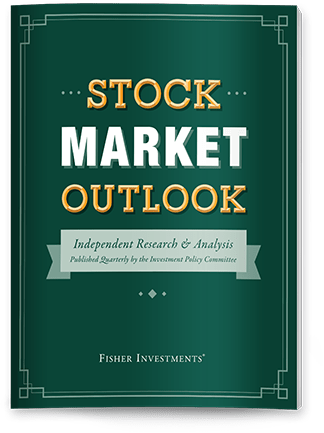Personal Wealth Management / Economics
October’s Flash PMIs Had More Treats Than Tricks
A few soft patches notwithstanding, developed world growth is stronger than appreciated.
October has had no shortage of headline fears, especially in the political sphere. An ongoing US government shutdown. Turbulent French and Japanese politics. Nonstop handwringing over the UK’s November Budget. But against that topsy-turvy political backdrop, the latest business surveys continue showing plenty of growth—an overlooked positive suggesting the global economy remains in better shape than appreciated.
As Exhibit 1 displays, S&P Global’s preliminary October purchasing managers’ indexes (PMIs) showed business activity rose in most major developed economies this month. (Readings above 50 indicate expansion.) PMIs report the breadth—not the magnitude—of growth or contraction, so they won’t shed much insight about how much GDP grew or shrank. But we still find PMIs a useful snapshot of business conditions in countries’ services and manufacturing sectors.
Exhibit 1: October and September PMIs

Source: FactSet, as of 10/24/2025.
Now, October’s results weren’t universally growthy, as Japan and France’s weakened from September. France in particular has been in a soft patch for a while. Its composite PMI (which aggregates both manufacturing and services) has been below 50 for 14 straight months through October, topping 50 just twice in the past two years.[i] This month, some respondents blamed “a volatile domestic political situation” for “reduced client spending appetites.”[ii] Perhaps that is true to some degree—we saw similar claims in France last summer after President Emmanuel Macron called a surprise snap election.
But “volatile politics” can also be a convenient scapegoat for weaker economic activity in general. It makes sense intuitively that a frustrating or scary development dampens consumers’ willingness to spend—even though in reality, how folks feel has little connection with their consumption decisions. Moreover, again, PMIs are breadth measures. If the minority of French firms that grew outpaced those that contracted, you can still get overall GDP growth. So it has been in seven of the last eight quarters, coinciding with PMIs’ soft streak.[iii]
Beyond the soft patches, business activity picked up in much of the developed world. For instance, don’t look now, but Europe’s largest economy may be shedding its “Sick Man of Europe” moniker. Yes, manufacturing remains mired in contraction, though fewer factories are reporting declines.[iv] But though manufacturing weakness tends to get eyeballs given Germany’s reputation as an industrial powerhouse, services (the bulk of German GDP) has been offsetting heavy industry’s struggles. Germany’s composite PMI rose for a fifth-straight month—its longest expansionary streak since early 2023—and registered a 29-month high in October despite manufacturing’s ongoing weakness. That overlooked resilience applies to the rest of the eurozone, too. According to S&P Global, “The euro area excluding Germany and France posted the fastest rise in activity for two-and-a-half years.”[v]
Across the Channel, UK economic activity rose amid nonstop warnings that Chancellor of the Exchequer Rachel Reeves’s November Budget will hamstring growth. Maybe, but history doesn’t support that thesis. Go back to last year’s Budget, which featured minimum wage and payroll tax hikes that became effective this April. Echoing the present, many warned those measures would hurt services businesses in particular, leading to layoffs and weaker growth. Indeed, UK services PMI dipped below 50 in April when those changes took effect—but since then, services have continued growing. If last year’s Budget provisions were negative for businesses, the UK services PMI indicates the effect was, at most, fleeting.
Here in the US, October’s flash PMIs were the strongest in a couple months, signaling a solid start to Q4. Notably, though respondents’ input costs continue to rise sharply (due largely to tariffs), most refrained from passing them on to customers for now, as they don’t want to lose market share.[vi] That said, there has been some divergence between S&P Global’s PMI and the Institute for Supply Management’s (ISM’s) version, as we wrote about last week. Divergence isn’t abnormal as the surveys poll differing businesses (in number and specific firms), but it is worth monitoring.
Despite US tariffs being broadly in effect, the global economy continues chugging along—countering fears trade levies would upend commerce. We aren’t saying tariffs are positive; they are economic negatives. Duties add friction to trade and end up hurting the tariff imposer more than the tariff target. But as Exhibit 2 illustrates, global economic activity has remained resilient.
Exhibit 2: JPMorgan Global Composite PMI Over the Past Three Years

Source: S&P Global, as of 10/24/2025. October 2022 – September 2025, the latest available data.
Some warn tariffs’ damage has been delayed by preemptive orders and the economic weakness will arrive eventually. Sure, many businesses worldwide did some pre-tariff frontrunning, but that already happened. If a deep pothole were to occur, we should theoretically be in it now. But PMIs’ overall growth suggests the pothole was shorter and shallower than feared. If tough times were around the corner, why did eurozone new orders pick up at their fastest pace in two-and-a-half years?[vii] America and the UK saw an upturn in new orders, too.[viii] Today’s new orders reflect tomorrow’s production, and you wouldn’t expect to see growth here if companies were planning to pull back soon.
Markets realized this better-than-appreciated reality back in April, but now, more folks are starting to notice, too. That optimism is rational and bullish, in our view.
If you would like to contact the editors responsible for this article, please message MarketMinder directly.
*The content contained in this article represents only the opinions and viewpoints of the Fisher Investments editorial staff.
Get a weekly roundup of our market insights
Sign up for our weekly e-mail newsletter.

You Imagine Your Future. We Help You Get There.
Are you ready to start your journey to a better financial future?

Where Might the Market Go Next?
Confidently tackle the market’s ups and downs with independent research and analysis that tells you where we think stocks are headed—and why.





